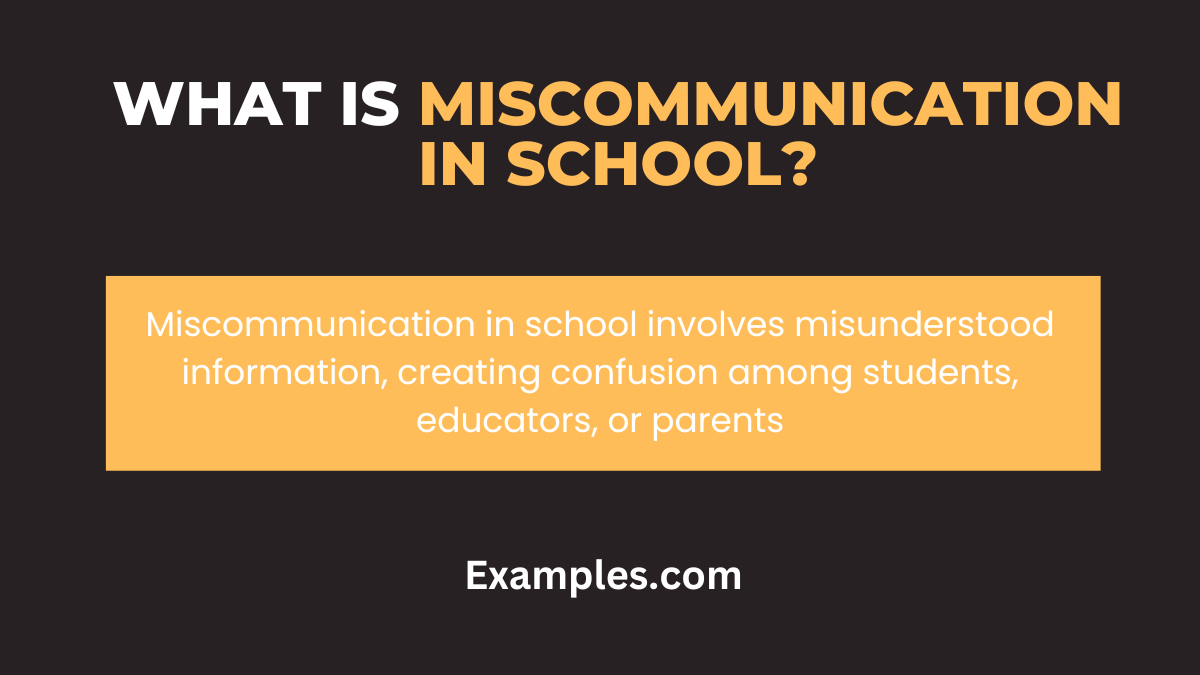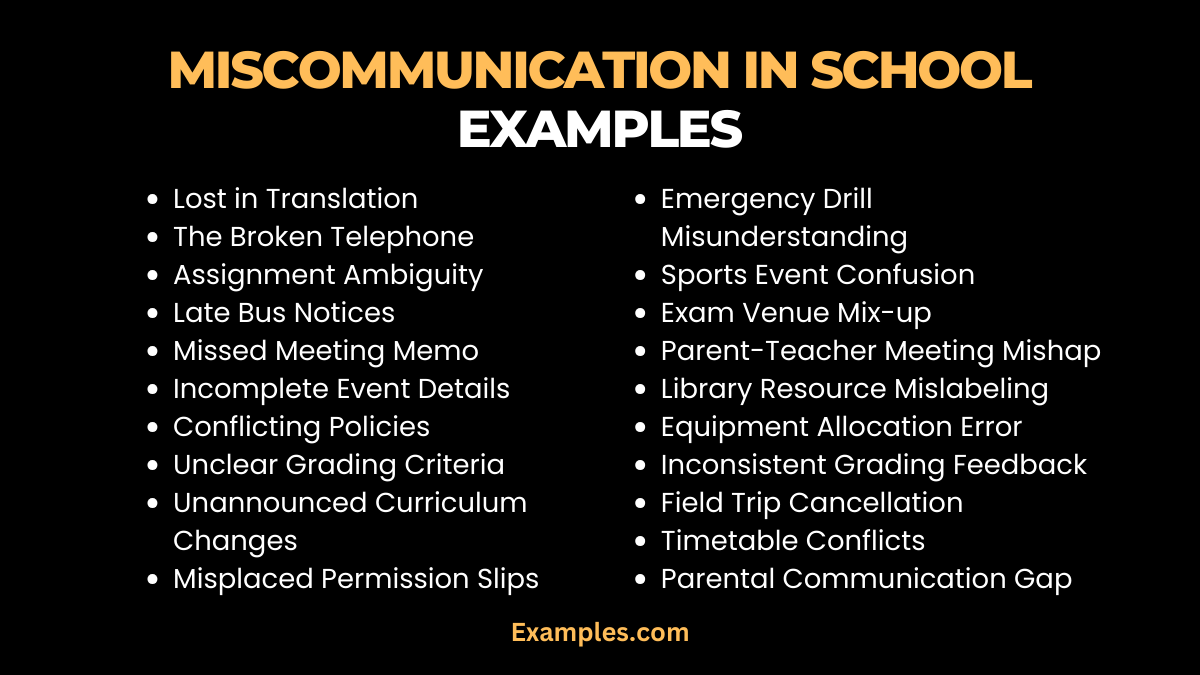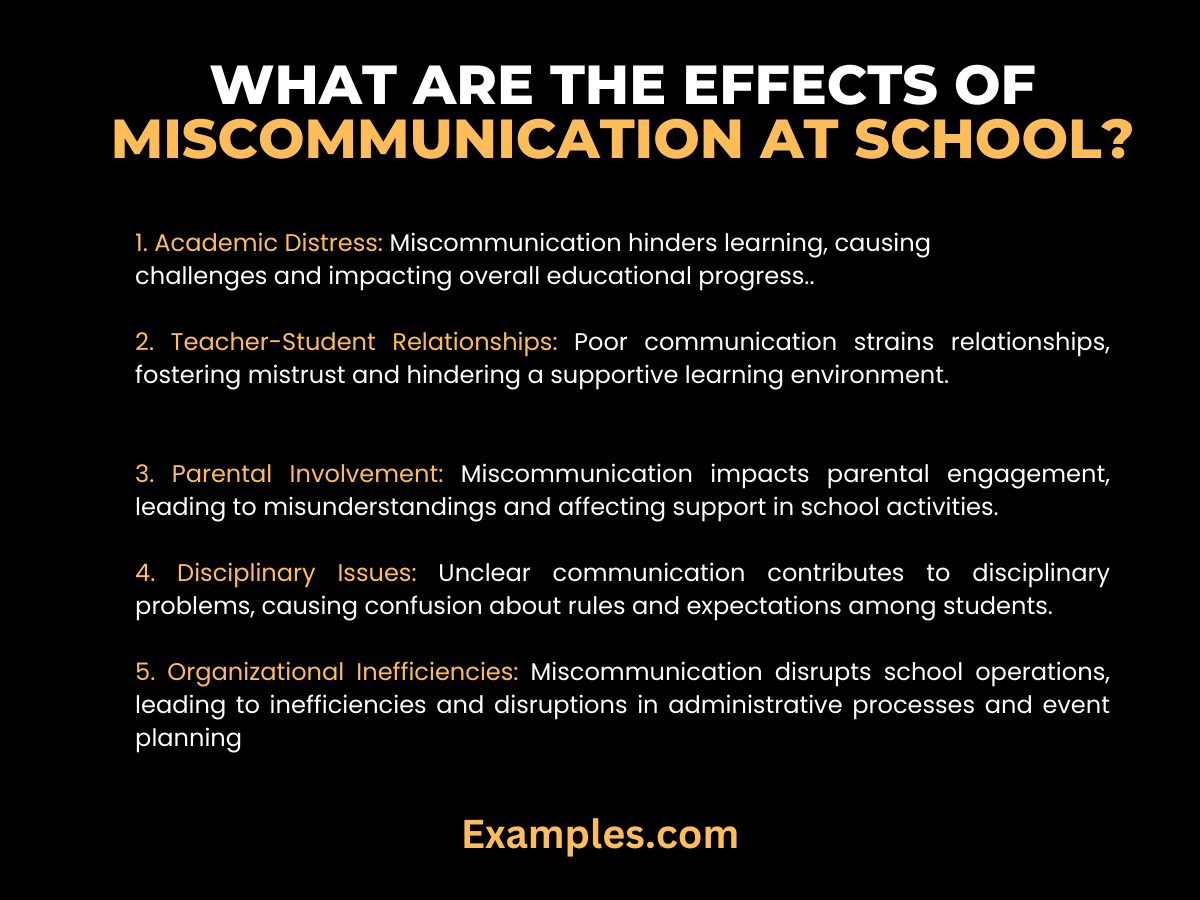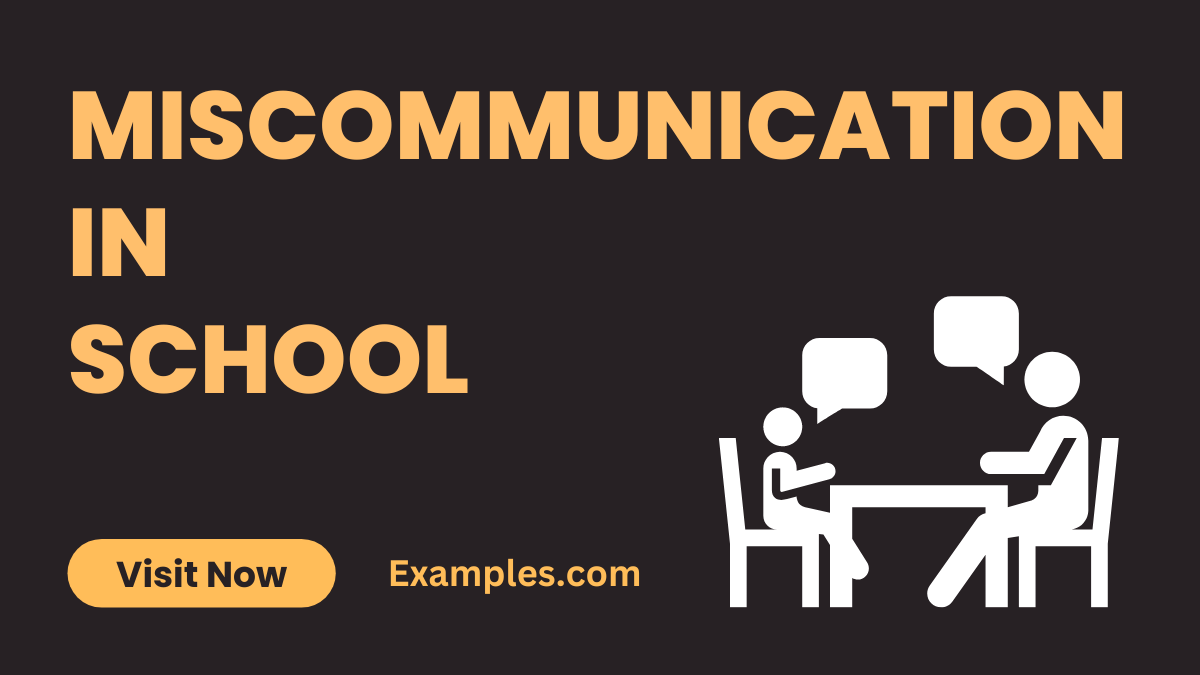19+ Miscommunication in School Examples
Embark on a comprehensive exploration of “Miscommunication in School” with our detailed guide. Uncover illuminating Communication Examples that shed light on common pitfalls and effective resolutions. In this insightful journey, we navigate through scenarios illustrating the importance of clear communication in educational settings. From classroom dynamics to faculty-student interactions, discover valuable insights and actionable tips for fostering effective communication within the school environment. Elevate your understanding and navigate the intricate landscape of school communication challenges with our in-depth guide.
What is Miscommunication in School?

Miscommunication in school refers to instances where information is misunderstood or inaccurately conveyed within the educational setting. In simple terms, it occurs when the intended message is not effectively transmitted, leading to confusion among students, educators, or administrators. This phenomenon can manifest in various forms, from unclear instructions to misinterpreted policies. Understanding the nuances of miscommunication is crucial for fostering a conducive learning environment and promoting effective interaction among all stakeholders in the educational system.
What is the best Example of Miscommunication in School?
Picture this: A crucial memo about a schedule change fails to reach all faculty members, resulting in chaos during an important school event. This prime example highlights the impact of miscommunication in schools. The breakdown in conveying essential information led to disruptions and confusion. Delve into the details of this scenario as we dissect the factors contributing to the miscommunication, providing valuable insights and lessons to prevent similar incidents in educational settings.
20 Miscommunication in School Examples:

Navigate through a vivid tapestry of school scenarios where miscommunication takes center stage. From teacher-student interactions to administrative hiccups, these instances illuminate the importance of clarity in educational settings. Uncover practical lessons and insights to enhance communication within schools.
- Lost in Translation: A classic miscommunication where instructions are misunderstood, leading to confusion. “Lost textbooks during class change resulted in a flurry of misplaced assignments.”
- The Broken Telephone: See the ripple effect of distorted information as it travels through students, morphing the original message. “What started as a simple announcement turned into a game of misinformation.”
- Assignment Ambiguity: Unclear task instructions create confusion among students, impacting the quality of work. “Vague project guidelines left students uncertain about the assignment’s objectives.”
- Late Bus Notices: Miscommunication about bus schedules leaves students stranded, waiting for buses that never arrive. “Late notices failed to reach students, causing delays and missed classes.”
- Missed Meeting Memo: Faculty misses a crucial meeting due to a poorly communicated change in schedule. “A last-minute rescheduling went unnoticed, leading to an absent faculty during a key meeting.”
- Incomplete Event Details: A lack of comprehensive information results in chaotic school events. “An incomplete event brief caused confusion among participants, affecting the overall experience.”
- Conflicting Policies: Confusion arises when different teachers enforce contradictory classroom policies. “Mismatched expectations led to disciplinary issues due to conflicting classroom rules.”
- Unclear Grading Criteria: Students struggle when grading criteria are poorly communicated, affecting their performance. “A lack of clarity on grading parameters left students unsure of how to excel in assignments.”
- Unannounced Curriculum Changes: Unexpected shifts in lesson plans catch students off guard, impacting their understanding. “Sudden changes in the curriculum left students unprepared for assessments.”
- Misplaced Permission Slips: Vital information about field trips is lost, resulting in students missing out on valuable experiences. “Miscommunication about permission slips led to some students being excluded from a field trip.”
- Emergency Drill Misunderstanding: Miscommunication during emergency drills can create unnecessary panic among students. “A misinterpreted alarm during a drill caused unnecessary distress among students.”
- Sports Event Confusion: Lack of clear communication regarding sports event schedules leads to missed games. “Students missed cheering for their teams due to confusion about match timings.”
- Exam Venue Mix-up: Students face stress and confusion when the exam venue is inaccurately communicated. “A venue mix-up left students rushing to find the correct exam location on test day.”
- Parent-Teacher Meeting Mishap: Miscommunication about meeting times leaves parents and teachers frustrated. “Conflicting information about parent-teacher meetings resulted in missed opportunities for crucial discussions.”
- Library Resource Mislabeling: Misleading labels on library resources hinder students’ research efforts. “Miscommunication in resource labeling led to students relying on inaccurate information for projects.”
- Equipment Allocation Error: Misunderstandings about equipment availability impact planned activities. “Double-booked equipment resulted in canceled activities due to miscommunication.”
- Inconsistent Grading Feedback: Teachers’ varied feedback on assignments creates confusion among students. “Inconsistent grading feedback left students uncertain about their performance and improvement areas.”
- Field Trip Cancellation: Miscommunication about canceled field trips disappoints eager students. “Last-minute trip cancellations left students disheartened due to lack of clear communication.”
- Timetable Conflicts: Clash in class schedules confuses students and disrupts learning routines. “Overlap in timetable schedules led to students attending conflicting classes.”
- Parental Communication Gap: Parents miss important announcements due to ineffective communication channels. “A communication gap between school and parents resulted in missed crucial updates and events.
Miscommunication in School at Workplace
Explore the intricate dynamics of miscommunication at the intersection of school and workplace. This insightful guide unravels scenarios where communication breakdowns impact both educators and staff, offering valuable lessons to enhance workplace harmony.
- Lost Handover Instructions: Failure to transition critical information from school to the workplace leaves staff uncertain about task priorities.
- Conflicting Expectations: Varied expectations between school and workplace create confusion in staff roles and responsibilities.
- Unclear Policy Implementation: Inconsistencies in implementing school policies at the workplace cause staff uncertainty and procedural errors.
- Incomplete Staff Meetings: Insufficient communication in joint meetings creates gaps in understanding shared goals.
- Delayed School Updates: Lag in sharing school events leaves workplace staff unprepared for sudden changes.
- Ineffective Cross-Training: Poorly communicated cross-training initiatives leave staff unequipped for collaborative projects.
- Unclear Project Handovers: Lack of clarity in transitioning projects results in delays and overlooked tasks.
- Mismatched Communication Tools: Discordant use of communication tools hampers effective collaboration.
- Inadequate Workplace Integration: Miscommunication about school values hinders successful integration into the workplace.
- Lack of Synchronous Training: Asynchronous training methods lead to misunderstandings and missed opportunities for synchronized learning
How to Avoid Miscommunication in School?
In education, effective communication is crucial. This guide provides practical tips for a miscommunication-free environment:
Understanding Miscommunication Dynamics: Grasp miscommunication’s dynamics, recognizing pitfalls, contributing factors, and impacts on students, educators, and parents.
Creating Open Communication Culture: Establish an environment fostering open dialogue to promote transparency among stakeholders.
Implementing Clear Communication Channels: Define and use tools for seamless information flow among administrators, teachers, parents, and students.
Setting Clear Expectations: Transparently communicate expectations for a harmonious school environment.
Regular and Timely Updates: Consistent communication about events, policies, and changes keeps everyone informed.
Establishing Protocols for Critical Information: Develop protocols for the smooth transition of vital information.
Training for Effective Communication: Educate stakeholders with programs enhancing communication skills.
Utilizing Technology Wisely: Leverage tech tools aligning with the school’s communication needs.
Encouraging Feedback Loops: Promote open feedback loops for continuous improvement.
Addressing Miscommunication Promptly: Learn to promptly address and prevent recurrence, maintaining trust
What are the Effects of miscommunication at school?

Miscommunication in school reverberates across various facets, shaping the educational landscape. This comprehensive guide explores the profound effects of miscommunication, shedding light on how it influences students, educators, and the overall learning environment.
- Academic Distress: Miscommunication disrupts the learning process, hindering students’ understanding of crucial concepts. This can result in academic challenges, affecting grades and overall educational progress.
- Teacher-Student Relationships: Poor communication strains relationships between teachers and students. It can create an atmosphere of mistrust, hindering the development of a supportive and conducive learning environment.
- Parental Involvement: Miscommunication impacts the engagement of parents in their child’s education. Incomplete or inaccurate information may lead to misunderstandings, affecting parental support and involvement in school activities.
- Disciplinary Issues: Unclear communication contributes to disciplinary problems within schools. Confusion about rules and expectations can lead to behavioral issues among students.
- Organizational Inefficiencies: Miscommunication affects the smooth functioning of school operations. From administrative processes to event planning, breakdowns in communication can result in inefficiencies and disruptions
How do Parents Miscommunication in School?
Effective parent-school communication is crucial for a child’s education. This guide explores how miscommunication can unfold, offering solutions for clearer communication channels.
Understanding Dynamics: Explore factors contributing to miscommunication – conflicting expectations and unclear channels. Understanding these dynamics is vital for prevention.
Common Scenarios: Delve into real-life scenarios – missed announcements, conflicting information – impacting the parent-school relationship.
Impact on Students: Uncover repercussions on students – missed opportunities, academic setbacks – highlighting direct influences on learning.
Identifying Signs: Awareness of signs indicating breakdowns empowers both parties to address issues proactively.
Communication Strategies: Explore practical strategies – transparent channels, regular updates – to bridge gaps and create a collaborative educational environment.
Transparent Communication Framework: Dive into the importance of transparency. Establishing a clear framework mitigates misunderstandings and builds trust.
Role of Technology: Discover how technology revolutionizes communication – dedicated platforms, real-time updates – ensuring accuracy.
Collaborative Environment: Foster collaboration through effective communication. Emphasize mutual understanding for a positive educational experience.
Addressing Challenges: Explore proactive measures – open dialogues, feedback mechanisms – empowering both parties to navigate potential pitfalls.
In conclusion, this comprehensive guide on Miscommunication in School provides valuable insights into the complexities of communication breakdowns. Through real-life examples and practical strategies, it illuminates the impact on students and offers solutions for fostering transparent and collaborative communication between educators, parents, and students. Embrace these lessons to create an environment where effective communication thrives, enhancing the overall educational experience.



